Chasing reliability and calculating risk
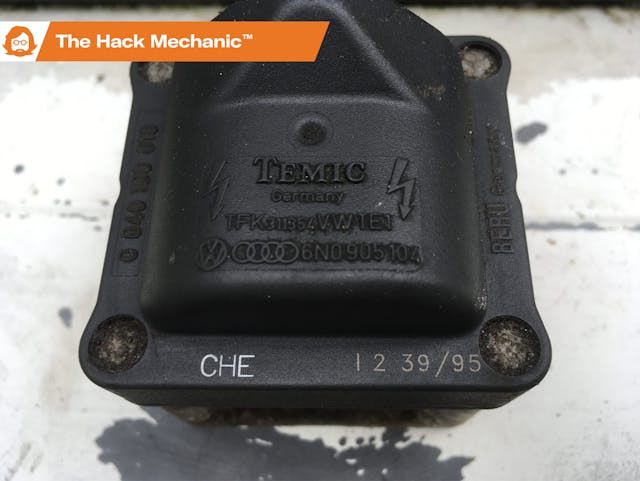
Recently, I’ve been writing about two very different vehicles—my 2003 E39 BMW 530i stick sport (the car that’s ostensibly my daily driver), and my 1996 Winnebago Rialta, which is a Volkswagen Eurovan with a Winnebago camper body that my wife and I use mainly for quick two- and three-day jaunts to campgrounds on the Cape. Although the vehicles are wildly different, they have something fundamental in common: They both recently suffered dying episodes that nearly stranded me.
I want to get them back to the point where I feel that they’re reliable enough to drive out of town again, while also trying to figure out when I should prophylactically replace a certain part … because if I don’t and the car dies on the road, I’ll feel like an idiot.
In the case of the E39, the root cause of its death and resurrection was almost certainly fuel-related, very likely a combination of a nearly-empty fuel tank and hot temperatures causing cavitation / vapor lock. Still, with 200,000 miles on the car, the prudent thing to do is to replace the fuel pump anyway, as it’s possible that running it like that—not immersed in fuel to cool it—may have caused it to overheat and shortened its already extended life. I haven’t replaced it yet, though, and the car soldiers on without a peep. However, if I take the car out of town and it dies—and the fuel pump is indeed the problem—I’ll feel pretty foolish. Also, it’s clear the car’s cooling system needs attention, so I’ve just parked it until I have the time to address both.
In the case of the Rialta, it had been sitting all winter before I began readying it for its first mini-outing on the Cape. I’ve nearly made a career out of writing about “The Big Seven” things likely to strand an older car (ignition, fuel delivery, cooling, charging, belts, clutch hydraulics, and ball joints). And #0 on that list, by the way, is tires, which are so likely to fail that nearly every vehicle carries a spare. While replacing the Rialta’s lower ball joints due to split boots, I noticed that the tires not only were obviously worn, but several of them showed cracks in the tread. I checked the date codes, and they were made in 2008.
As I wrote while preparing to shoot a video with Magnus Walker and my BMW M Coupe, I’ll sometimes flirt with the gray zone regarding tire age if the tread is good, but this is a 7000-pound vehicle, and cracks are another matter. I ordered new tires.
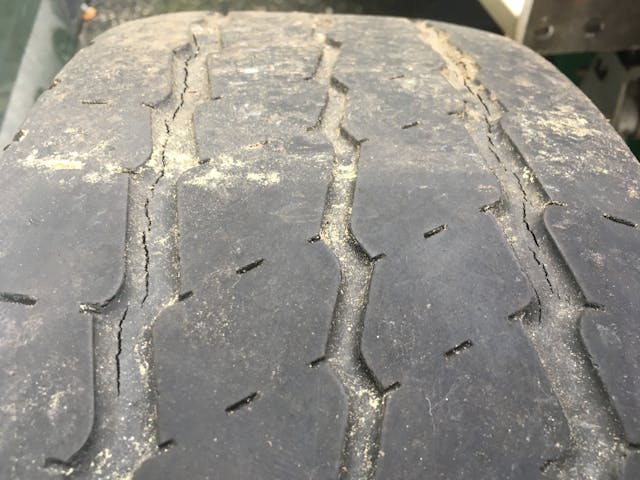
I then tried installing a new serpentine belt, couldn’t slacken the tensioner enough to get it on, checked the original belt for cracks, reinstalled it, squeezed the cooling hoses and found them firm, replaced a leaking receiver-drier and recharged the air conditioning, drove the Rialta, and found that the alternator’s charging of the battery at idle wasn’t keeping up with the drain from the A/C fans; the voltage on my cigarette-lighter voltmeter was dropping below 12 volts. This wasn’t new, but it seemed to be worse than in years past. Often low voltage is just due to worn brushes on the voltage regulator / brush pack, and replacing it is an easy fix. I already had a spare regulator and tried to install it but could not figure out how to get the alternator’s back cover past the tangle of cooling hoses behind it. I consulted a Rialta / Eurovan forum and learned that there’s basically no way to do it without pulling the alternator, which is not trivial due to the tight clearances.
Then, while examining all this beneath the car, I noticed some alarming coolant drips. They appeared to be coming from the lower edge of a plastic coolant neck bolted to the front side of the head. I theorized that all the shoving I did of the alternator’s rear cover might have lessened the pressure on one side of the rubber o-ring behind the neck. Over the next hour, the weeping gradually stopped.
I decided that neither of these things were showstoppers, ordered a Dorman version of the plastic coolant neck for $5.96 on Amazon to have in the RV as a backup, resolved to shift to neutral and rev the engine if I was in traffic and the charging voltage was low, planned to borrow the battery from my E39 BMW to have as a spare if the alternator / regulator crapped out completely, and vowed to renew my roadside service membership in Good Sam’s (the RV version of AAA) just in case things really didn’t go my way.

So, I took the little RV to the car wash and pressure-washed nine months of dirt and mildew off it. It looked so clean and happy. I was happy too.
Until it wouldn’t start.
I didn’t have any of my tools with me. I didn’t even have a can of starting fluid to help determine if the problem was spark or fuel (e.g., give it a blast of starting fluid, if it fires up and runs for a few seconds, then dies, it obviously has spark and the problem is likely fuel-related; if it doesn’t, it’s likely lack of spark). I thought exercising my just-renewed Good Sam’s membership for a tow home, but after twisting the key it at regular intervals for about 10 minutes, it started. It bogged down ominously a couple of times while driving it home, but I made it.
Over the next two days, I drove the Rialta about 30 miles on the highway and through stop-and-go traffic and didn’t experienced a single hiccup. However, the prospect of my wife and I taking it on a much-needed mini-vacation when it still had an undiagnosed starting-and-running ailment didn’t sit well with me.
As I wrote about with the E39 BMW, problems rarely go away or fix themselves. Instead, they generally get worse. My wife and I tossed around ideas. Was taking the RV to Provincetown inside the envelope of acceptable risk? Should we cancel the trip? Or should we split the difference—I drive the RV and have her follow me in another car so at least we’d have wheels and options if things went south?
Now, the cause of a vintage car not starting in the rain is usually traceable to old-school ignition issues—water either getting under the distributor cap or soaking into cuts in old plug wires and causing spark to arc somewhere other than to the plugs. In fact, I’d had it happen at this very same car wash years ago when I pressure-washed that bastion of dependability, a 1992 FJZ80 Toyota Land Cruiser. In that case, though, I’d foolishly pressure-washed the engine compartment, and water had forced its way under the distributor cap. This time, though, with the Rialta, I hadn’t even raised the hood. Plus, although ignition figures prominently in “The Big Seven,” the ignition in modern cars is usually far more reliable than old points-and-condenser systems in vintage vehicles.
Since buying the Rialta four years ago, we’ve used it maybe 10 times for these short campground trips. It stranded us once when it popped a brake line, but that wasn’t a known issue that I ignored, so I didn’t kick myself for it, and a wonderful repair shop had us back up and about in a day. In general, I’ve fixed what needed fixing, but never really gave the Rialta a thorough preventive maintenance scrubbing (it didn’t really seem to need it; there was a $3950 bill from the previous owner that seemed to address most ignition and cooling system issues). Nor have I learned the ins and outs of the “Digifant” ignition / injection of its little Volkswagen-Audi 2.5-liter five-cylinder 100-horsepower engine. It was clearly now time to educate myself.
As I searched on Rialta and Eurovan forums, I learned that the car’s digitally-triggered “coil pack” (a single external module, not individual “stick coils” on each plug buried under the valve cover) is a weak point. Further, I began seeing alarming reports about “Sudden Death Syndrome,” where the cars suddenly lose power and die. Some of these posts were heartbreaking, as folks described RV trips interrupted multiple times by dead vehicles, tows, hotel stays, and expensive repair bills, only to have the problem recur 200 miles down the road. Many of the SDS posts implicated the fuel pump and the pulse module that lives inside the distributor. I wasn’t certain, though, whether this was what I was experiencing, as my problem had happened when the car was wet, not when it was warm.
A few days after the Rialta’s car wash event, I went out to the driveway to flush the power steering fluid and change it to the proper Pentosin CF11, hoping it might quiet down a whine in the power steering pump. The car wouldn’t start. Good, I thought! Dead cars are much easier to diagnose than ones with intermittent problems, and dead in your driveway is infinitely preferable to dead by the side of the road. And, I realized, it had rained the night before. The coil pack certainly wasn’t sitting in water, but things were damp from the humidity.
But, diagnostics-wise, first things first. I pulled the fuel pump relay, bypassed it with a jumper wire from pins 30 to 87, and heard the fuel pump run and felt fuel running through the fuel lines, so it seemed unlikely to be a fuel delivery problem. I squirted starting fluid into the intake, and the car didn’t start, indicating that spark wasn’t present. Right, things all pointing to an ignition issue. But when I pulled the center wire from the coil, held it near ground, and had my son crank the engine, I got spark. Most strange. I put it back together, and after a few tries, it magically started back up.
Hmmmmm.
I did more reading and found a good Digifant diagnostic tree. I learned that the pulse module in the distributor creates the triggering signal, sends it to the ECM which modifies it, and then sends it to the coil. Both the pulse module and the coil pack have simple three-wire connectors that can be checked for voltage, ground, and signal using a multimeter and a simple test light. The pulse module looked good, but I couldn’t get a triggering signal on the connector to the coil pack, which seemed to point to the ECM, unless of course I was doing the test wrong. Since I was getting spark from the good old-fashioned “hold the center distributor wire next to ground” test, I decided it was likely I was doing it wrong.
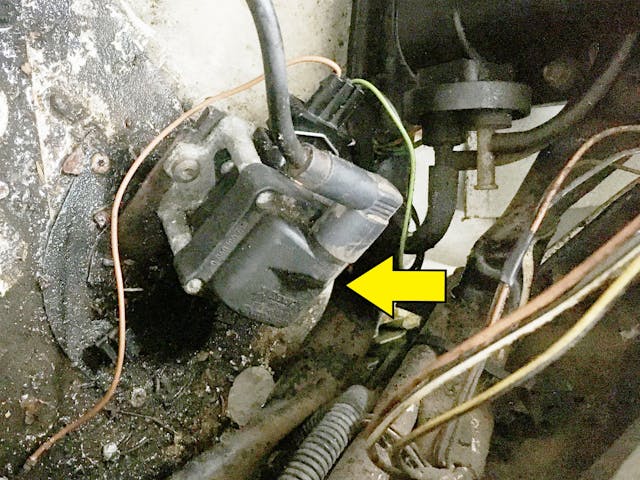
OK. It croaked—twice—when it was wet. So, let’s get it wet and see if we can flip it back from running to dead. I took the garden hose and set the nozzle to its lowest, widest setting.
And now, a quick story. I remember watching a documentary a few years ago on the Columbia space shuttle disaster. There was a theory that foam that had broken off one of the external fuel tanks and hit one of the wings during launch might have knocked a hole in the heat-resistant tiles and been the cause of the shuttle disintegrating. Researchers made a mockup of the wing / tiles and prepared to shoot foam at it at hypersonic speeds. As the cameras rolled, the researchers downplayed the expectations, saying that a negative on one shot would prove nothing. They shot the foam, and BLAM it blew a hole through the tiles of the mockup wing. Everyone was speechless. So, a negative wouldn’t have meant much, but a positive meant everything.
So, I spritzed the coil pack, but knew that it might not prove anything.
The car immediately stumbled and died.
Gotcha.
I then put my head near the coil pack, pulled the hood down over my head to make it as dark as possible, and had my son crank the engine. I could see spark arcing from the base of the distributor wire to the body of the pack. Even after the coil dried out and the car ran again, I could make it misfire and die simply by twisting the coil wire. It was almost certain that the case to the coil pack was cracked, though the crack wasn’t visible to me.
I did more reading and learned that while the coil pack for this generation of Digifant is available at big-box auto parts stores like Autozone, the aftermarket brands they sell don’t have a good reputation. And, for that, they’re pricey. I looked online on FCP Euro where I buy a fair amount of parts these days, as they’re just down in Connecticut and ship quickly. They had the coil pack from the OEM supplier Beru at a good price. What’s more, they also had OEM versions of the pulse module and the fuel pump, just in case I was wrong about the coil pack. I called them and verified they had the parts in stock.
Since I had an appointment to get the tires replaced first thing in the morning and was scheduled to leave for the Cape the morning after that, I couldn’t afford to be wrong about the diagnosis. I mapped out the drive. It was five hours round-trip from West Newton, Masachusetts, to FCP in Milford, Connecticut. I didn’t want to take the E39 BMW since I still had the jitters about not having replaced the fuel pump or cooling system yet. It was raining, so I didn’t want to take any of the vintage cars. So I burned on down there and back in my M Coupe. It wasn’t exactly hardship.
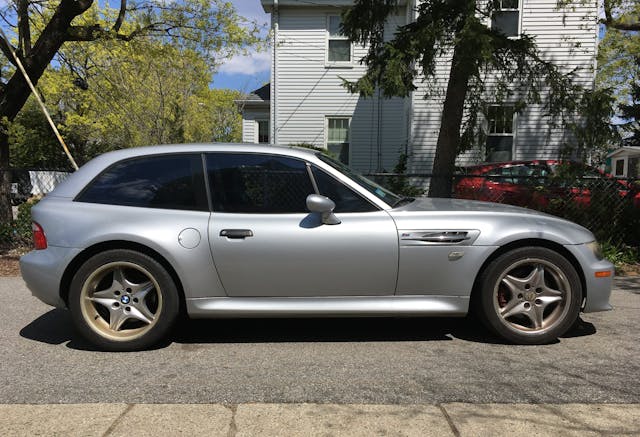
When I removed the old coil, I could plainly see the crack. It was on the side where it wasn’t visible when the coil installed.
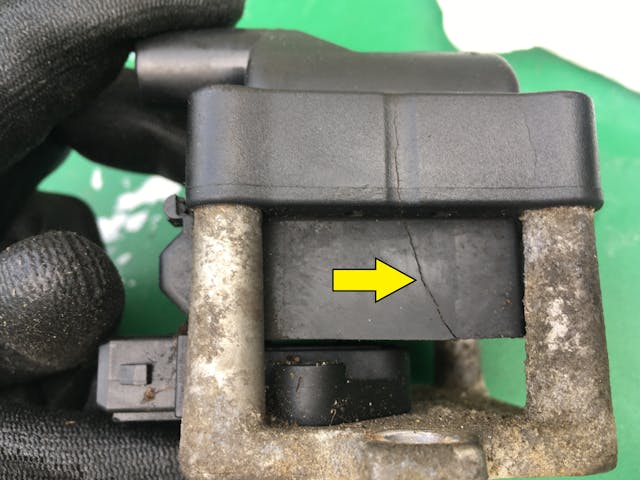
Moreover, the coil had a “95” date stamp, so it was original to the car.
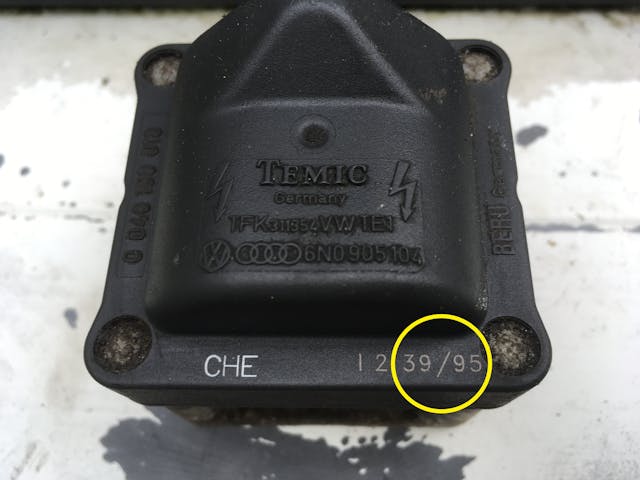
I installed the new coil. The little RV started instantly and sounded and ran smoother. I gave the coil more than just a little spritz with the hose. No stumble, no death. Man, that feels good.
I then completed the power steering fluid flush, disconnecting the lower hose, running the engine, rotating the steering wheel left to right several times to pump out all the old fluid, and refilling it with fresh Pentosin CF11. Unfortunately, when I went to dispose of the oil fluid, I saw a thin silver circle in the drain pan, which of course was one of the crush washers that should have been on the banjo bolt through the hose fitting. Fortunately, I was able to squeeze the hose and prevent most of the fluid from running out when I undid the banjo bolt and replaced the errant fitting. Unfortunately, the fluid change had no effect on the whining power steering.
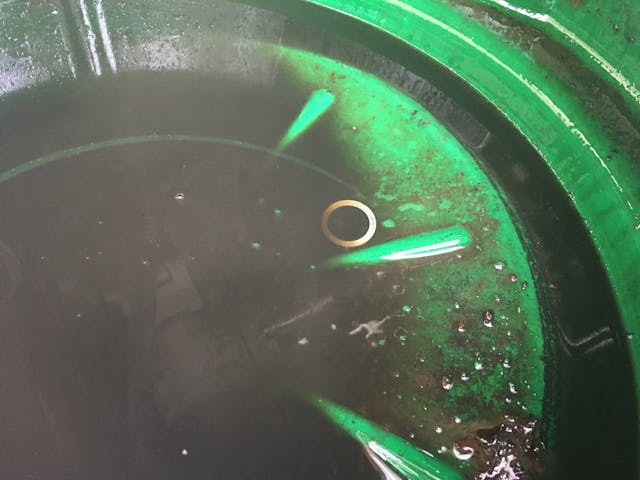
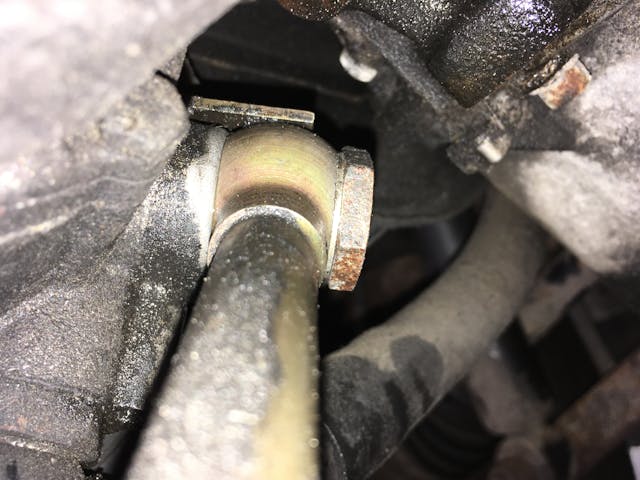
So, as I send this in, my wife and I are packing the Rialta and are about to drive to Provincetown for a few days. I can almost feel the correctly-created and collapsing magnetic fields from the new coil generating an aura of dependability around the little RV. Yeah, this is how it should be.
I did, however, still pack that plastic coolant neck. And the spare battery from the E39. And spare the pulse module and fuel pump I’d just bought. I’m not an idiot.
(Next week: Did we make it? And what are the larger lessons regarding preventive maintenance and reliability?).
***
Rob Siegel’s new book, The Best Of The Hack MechanicTM: 35 years of hacks, kluges, and assorted automotive mayhem, is available on Amazon. His other seven books are available here, or you can order personally-inscribed copies through his website, www.robsiegel.com.


Ah yes! The dreaded nearly empty gas tank and the fuel pump that is cooled by the liquid it pumps. On a hot summer’s day that scenario will leave you walking for sure. Dropping the gas tank when it’s empty is usually a pretty straight forward task given that those tanks are usually held on the vehicle by a couple of easy to undo straps. IF you have the right tools on board. I have personally done those repairs in my shop and found them easy BUT on the side of the road, not so nice! You are a thoroughly entertaining writer Mr. Rob Siegel. Thank you for many hours of entertainment.